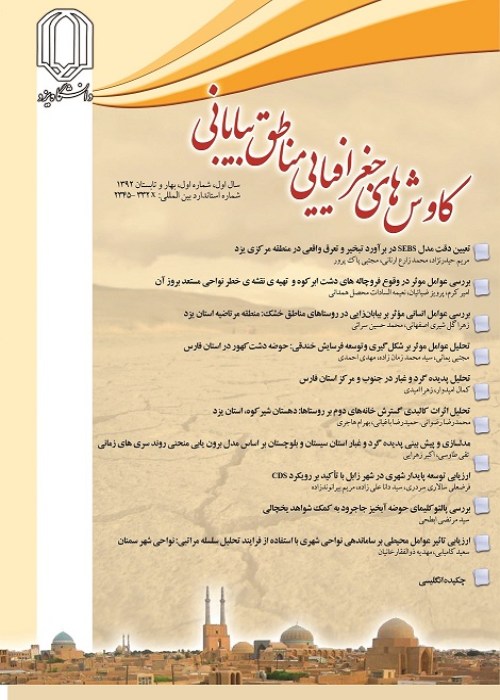Spatial Analysis of Heat Islands in Qom as an Index of Urban Environment
Due to the phenomenon of urbanization, the types of land cover in urban areas have changed, which eventually leads to the formation of a distinct climate. Among these, urban heat islands are one of the most prominent phenomena in which some urban areas, especially city centers, will have temperatures several degrees warmer than the surrounding suburbs. Replacing the natural ground cover with paving, structures, asphalt and other urban constructions will eliminate the cooling effects of natural surfaces; So that by changing the pattern of local winds, enhancing the growth of clouds and fog, increasing the amount of lightning and the impact on rainfall, will change the climatic and local weather conditions. One of the most important parameters in the study of the heat island in the city is the Land surface temperature (LST). In general, surface temperature measurements are performed by meteorological stations, including synoptic and climatology. It should also be noted that meteorological stations are only able to measure temperature in certain places where they are already installed. What is considered as a major shortcoming in monitoring the surface temperature is the lack of sufficient meteorological stations to know the temperature values in places without stations. The aim of this study is extracting the surface temperature in Qom city in the period of 1379 and 1399, the temporal and spatial changes of land surface temperature using spatial statistics and finally identifying the critical environmental areas in Qom city.
For spatial monitoring of heat island in Qom city, first Landsat satellite images of ETM+ and OLI/TIRS sensors related to Qom city (row 165 and route 36) for the years 2000 to 2020 (9 images) related to September in Clear weather conditions (cloud cover less than 1%) were obtained from glovis.usgs.org. In the first step after taking the images, all the required corrections, including atmospheric correction and radiometric correction were applied to the images. In the second step, one of the most valid methods, namely the Split Window algorithm, was used among the various methods for calculating the ground surface temperature, such as single-window, single-band and Sabal algorithms. In the next step, global Moran and local Moran’s I indices were used to analyze spatial autocorrelation and Gi* statistic was used to analyze hot and cold spots. Finally, to determine the urban environmental status, the deductive method of urban Environmental Criticality Index (ECI) was used.
According to the results, it was found that from 2000 to 2020, low and very low temperatures correspond to green space and vegetation, medium temperatures correspond to urban uses and high and very high temperatures correspond to the outskirts of the city and barren lands. . To determine the type of spatial correlation between land surface temperature in the two years, the global Moran spatial autocorrelation index was used. Based on the results of global Moran analysis, in both years (2000 and 2020) it was found that there was autocorrelation between the data and the data were distributed as clusters with high concentration in space. In order to show spatial changes and provide a clear picture of the distribution of temperature values in the city of Qom, the local Moran’s I index was used. According to results, the distribution of points in the obtained years has been such that high clusters in the two years 2000 and 2020 were on the outskirts of Qom. These clusters in both studied years corresponded to barren lands which had an increasing trend during the study period. Examining the Environmental Criticality Index, it was found that due to the creation of heat zones and the occurrence of a steep heat slope around the city over time, high-sensitivity zones in the study period around the city had an increasing trend. Examining the NDVI map, it can be clearly seen that the highest environmental sensitivities occurred in low value NDVI values and the lowest environmental sensitivities occurred in reverse values.
By spatial and temporal monitoring of the heat islands in Qom, it was determined that during a period of 21 years (2000 to 2020), the temperature around the city compared to the internal temperature has had an increasing trend. In other words, it can be said that the areas of hot heat peninsula are formed on the outskirts of the city and cold heat islands are formed in the center of Qom city. Existence of green space inside the city, existence of dry and barren lands around the city, semi-arid climate, etc. have caused the areas around the city to have a trend of increasing temperature, and as a result, the central areas of the city due to their low temperatures relative to the surrounding areas appear as cold heat islands.
- حق عضویت دریافتی صرف حمایت از نشریات عضو و نگهداری، تکمیل و توسعه مگیران میشود.
- پرداخت حق اشتراک و دانلود مقالات اجازه بازنشر آن در سایر رسانههای چاپی و دیجیتال را به کاربر نمیدهد.


